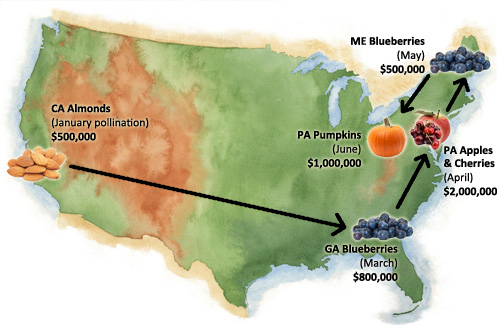18
Jan
GMO Development in Europe Takes a Hit, Focus on U.S. Markets To Intensify
(Beyond Pesticides, January 18, 2012) Given the persistent wariness of genetically modified organisms (GMOs) in Europe, Germany’s BASF will stop developing new products targeting the European market. The group announced on January 16 that it plans to refocus its activities in the sector on more receptive regions. Unfortunately, this means BASF will redouble its efforts in the U.S. to develop new GMO products, leading to public and environmental health concerns in this country.
In a statement, a BASF representative announced, “Biotechnologies are not accepted enough in many parts of Europe by the majority of consumers, farmers and political leaders. That is why it does not make sense economically to continue to invest in products aimed exclusively at this market.” BASF promotion of its GMO products has been stalled in the last couple years. BASF fought for a decade before obtaining European Union (EU) marketing authorization in 2010 for Amflora, a genetically modified high-starch potato. Shortly afterwards BASF mistakenly planted in an Amflora field in Sweden another of its GMO potatoes, Amadea, which had not received authorization from European officials. According to the company, after this scandal, “European sentiment towards transgenic products declined further.” BASF plans to halt the planting and marketing of Amflora, initially grown on around 300 hectares in three countries, but limited last year to a two hectare field in Germany. Its sales in 2011 were close to zero. Research and development on other transgenic products aimed solely at the European market, including a mildew resistant high-starch potato and a variety of fungus resistant wheat, will also be halted.
Greenpeace hailed the BASF decision as a “a victory for consumers” and a “step towards the development of safe biotechnologies.” Friends of the Earth Europe echoed the same view. “This is another nail in the coffin for genetically modified foods in Europe. No one wants to eat them and few farmers want to grow them,” said Adrian Bebb, a representative for Friends of the Earth.
However, in setting its sights on the North and South American markets, BASF has decided to relocate the seat of its biotechnology activities to Raleigh, North Carolina from two German sites and one in Sweden.
European farmers have long defended their right to grow non-GMO food. The EU has several policies that strongly regulate genetically modified materials from food including one for honey, which states that honey produced though cross-pollination with a GM crop must be authorized as a GM product before being sold. In 2009, Ireland passed a policy banning the cultivation of all GM crops and introduced a voluntary GM-free label for food.
Conversely, the U.S. has in recent times moved to deregulate GMOs. Most recently, USDA approved another GM seed by industry giant Monsanto, a drought-tolerant variety of corn, MON87460, and opened up a 60-day public comment period on corn that has been genetically engineered to resist the herbicide 2,4-D. This follows other decisions to deregulate and allow the cultivation GM alfalfa and sugar beets, despite contamination risks posed to both organic and conventional farmers. Monsanto also announced plans to renew its efforts to develop genetically modified wheat. Just last week a U.S. District Judge issued a ruling, finding that the decision to deregulate GM alfalfa was not unlawful, as was charged by organic and environmental advocates, including Beyond Pesticides.
The U.S. decision to deregulate GM crops fails to take into account several scientifically-validated environmental concerns, such as the indiscriminate nature of genetically modified gene flow in crops, a heavy reliance on faulty data, and a high degree of uncertainties in making safety determinations. It also overlooks the problem of herbicide resistant weeds and insects, as well as the widespread corruption of conventional seed varieties by GM strains, along with documented severe economic injury to farmers and markets. There is also an oversight of possible health consequences from eating GMOs, despite the fact that long-term health effects of consuming GM food are still largely unstudied and unknown. A recent report highlights scientific research and empirical evidence around the globe demonstrating the failure of GMOs to deliver on their advertised promises to increase yields, reduce pesticide usage, and tolerate drought with “climate ready” traits. In March 2011, 60 family farmers, seed businesses, and organic agricultural organizations preemptively filed suit against Monsanto in an effort to protect them from patent infringement in the event of drift contamination by Monsanto’s GM seed.
Fortunately, GM crops are not permitted in organic food production. For more information about why organic is the right choice, see our Organic Food: Eating with a Conscience Guide and visit the Organic Program page. For more information on the failure of genetically engineered food, read “Genetically Engineered Food Failed promises and hazardous outcomes,” from the Summer 2011 issue of Pesticides and You, or go to our Genetic Engineering web page.
Source: Europolitics












 (Beyond Pesticides, January 10, 2012) A Purdue University study shows that honey bees’ exposure to the highly toxic neonicotinoid pesticide
(Beyond Pesticides, January 10, 2012) A Purdue University study shows that honey bees’ exposure to the highly toxic neonicotinoid pesticide 
 (Beyond Pesticides, December 19, 2011) The 30th National Pesticide Forum,
(Beyond Pesticides, December 19, 2011) The 30th National Pesticide Forum,  Carl Young, interim executive director of the League to Save Lake Tahoe/Keep Tahoe Blue, told the Associated Press that the plan poses a threat to the lake’s water quality and the public’s health, and he’s concerned visitors and residents could be exposed to pesticides through Tahoe’s fish and drinking water. The League is urging regulators to use non-chemical methods, including bottom barriers that involve the use of large mats to starve the species of sunlight and oxygen. The aquatic plants can be managed through mechanical harvesting.
Carl Young, interim executive director of the League to Save Lake Tahoe/Keep Tahoe Blue, told the Associated Press that the plan poses a threat to the lake’s water quality and the public’s health, and he’s concerned visitors and residents could be exposed to pesticides through Tahoe’s fish and drinking water. The League is urging regulators to use non-chemical methods, including bottom barriers that involve the use of large mats to starve the species of sunlight and oxygen. The aquatic plants can be managed through mechanical harvesting.
 (Beyond Pesticides, December 8, 2011) We are pleased to announce that Mark Keating, a conservation biologist with over 16 years’ experience in the organic science and policy, most recently as policy expert with the U.S. Department of Agriculture’s (USDA) National Organic Program, is the latest addition to the Beyond Pesticides staff. Mr. Keating will serve as Beyond Pesticides’ Senior Scientist. Among other things, he will bring his expertise to Beyond Pesticides’ work on
(Beyond Pesticides, December 8, 2011) We are pleased to announce that Mark Keating, a conservation biologist with over 16 years’ experience in the organic science and policy, most recently as policy expert with the U.S. Department of Agriculture’s (USDA) National Organic Program, is the latest addition to the Beyond Pesticides staff. Mr. Keating will serve as Beyond Pesticides’ Senior Scientist. Among other things, he will bring his expertise to Beyond Pesticides’ work on 
